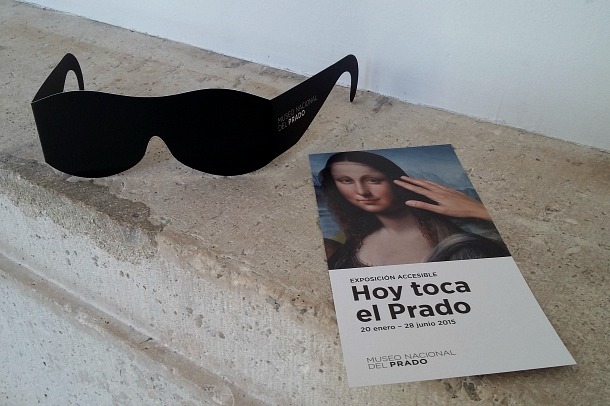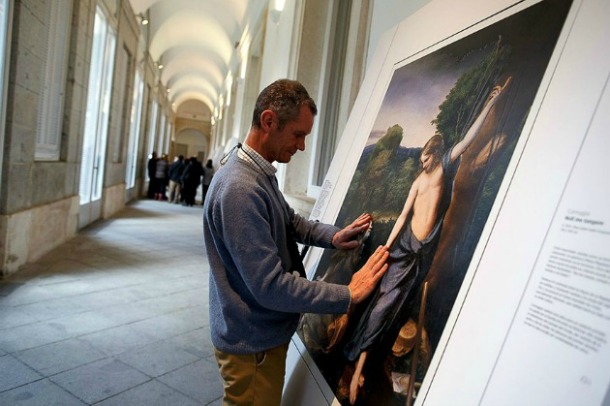Please touch the paintings! This is a sentence we don’t usually hear in museums. At the innovative exhibition in Madrid’s famous Prado Museum everything is possible.
Visually impaired people have the chance to “see” paintings through touching them, reading about their background and listening to some stories through the audio guide. At the same time, fully-sighted visitors get opaque glasses and try to enjoy art in the same way as if they couldn’t see.
Hoy toca el Prado (Touching the Prado) is the first initiative of Museo Nacional del Prado which is focusing on visually impaired visitors. As a result of the project, six works of Prado’s collections are “copied” and exhibited in the North Gallery of the museum.
Even though we could hear news about similar experiments in other museums before, they have never stepped forward from the black and white embossed pictures. Fernando Pérez Suescun, the curator of the exhibition decided to keep the colours of the paintings as some of the visually impaired people can still see the colours and the forms to some extent.
The copies are created using 3D printing techniques. Visitors are able to get the feeling of the textural complexity of some of the important masterpieces of fine art. While touching, you can distinguish clothes and textiles from human skin. It is also possible to discover little details, such as decorations of vases, leaves of flowers or even the year the painting was made.
The paintings are from various artists and they represent different pictorial genres. And most importantly: they can be touched. No space and barriers between the artwork and the visitor, no shouting from employees if you cross the line.
Entering the corridor of the exhibition, suddenly there is total silence waiting for me in the middle of one of the world’s most famous museums. I’m the only one there. Like this I have the chance to put on my black glasses and go through the pictures, not afraid of touching anything or spending too much time exploring the paintings in a different way that I’m used to.
Starting with the opening Biblical picture of Noli me tangere (Touch me not) from Correggio, I’m passing by other pieces of art such as the Still life with Artichokes, Flowers and Glass Vessels, until I arrive to the last painting, the Parasol from Goya.
For a long time I’m only touching the pictures thoroughly, trying to put myself in the situation of a visually impaired person. Even though I have the intention in each case to keep my eyes closed, I always have to see the painting in the end – just to realize what I have missed (an action some of the other visitors wouldn’t have the chance to do).
Most probably I have never spent that much time in front of a painting – or better to say with a painting, as I could get much closer physically and mentally to them than usually. While touching, I also pay more attention to the location of the figures, the textures of the objects and the little details I might have missed otherwise.
“For us the sense of sight is the sense of touch” – told one of the visitors at the exhibition opening.
“My view is to touch, and usually I can’t see the paintings others see in a museum – someone would have to explain them to me. But in this exhibit, I have the chance to see them with my hands.”
“On the one hand I more or less remember the paintings from when I was young, but on the other hand it is a totally different experience to touch all the little details of the pictures. It is as if I could see again” – added another visitor who lost his eyesight 35 years ago.
Even though they can feel the textures, the shapes and the figures or even the little details of the masterpieces, unfortunately there are some parts which visually impaired people would miss for sure. They can’t see the colours of the paintings or the sunshine coming through the windows, leaving strange temporary patterns on the paintings.
While I was leaving the corridor of Prado, memories from another exhibition came into my mind. Now already for many years there is a permanent Invisible Exhibition at Budapest: you enter some rooms, where for a whole hour you are guaranteed not to see anything, as there is no daylight coming into the area. You “turn blind” for the duration of the visit.
Compared to the Prado visit, there you don’t have the chance to get back your eyesight just with opening your eyes. You have to suffer and deal with everyday situations the same way as visually impaired people. You have to cross a busy road in the rush hour, another task is to recognize some of the world’s most famous sculptures just by touching them, and if you want to eat something you must find the equipments for cooking in the kitchen.
A visually impaired person helps you through the journey. In the meantime, visitors can ask honest questions from the guides, so that they can have a full impression about how they are coping with the difficulties during an average day.
This time the goal is different. At the Hoy toca el Prado exhibition the visually impaired visitors are in the focus. The most important is to give them the opportunity to be in a museum, to feel and touch the paintings – not just to listen to other people talking about them.
***
Hoy toca el Prado is open until the 18th of October. Entry is free for the visually impaired and those helping them to visit the museum.







